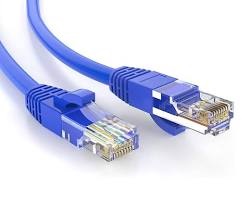Home »
IoT (Internet of Things) Tutorial
IoT Data Communication - How to transfer data using Wireless / Wired connectivity?
By Shahnail Khan Last updated : November 08, 2023
IoT data communication is the process of transferring data between IoT devices and other devices, such as gateways, cloud servers, and mobile apps. This data can be used to monitor and control IoT devices, collect data for analytics, and automate tasks.
There are two main types of IoT data communication: wired and wireless. Wired communication uses a physical medium, such as an Ethernet cable, to transmit data. Wireless communication uses radio waves or other electromagnetic signals to transmit data without physical cables.
Wired IoT Data Communication
Wired IoT data communication is the most reliable and secure type of IoT data communication. It is also the fastest, with data rates of up to 100 Gbps or more. However, wired IoT data communication can be more expensive and complex than wireless IoT data communication.

Fig: Ethernet cable
Let's have a look at some of the most common wired IoT data communication technologies.
- Ethernet: Ethernet is the prevalent wired networking technology employed for linking IoT devices to the internet.
- Power Line Communication (PLC): PLC uses electrical wiring to transmit data. This makes it a good option for connecting IoT devices that are difficult to reach with Ethernet cables.
- Serial communication: Serial communication is a simple and inexpensive way to connect two IoT devices. It is commonly used to connect sensors and actuators to microcontrollers.
Wireless IoT Data Communication
Wireless IoT data communication is more convenient and flexible than wired IoT data communication. It is also easier and less expensive to implement. However, wireless IoT data communication is less reliable and secure than wired IoT data communication. It is also slower, with data rates typically ranging from a few kilobits per second to a few megabits per second.

Fig: Cellular network
Let's have a look at some of the most common wireless IoT data communication technologies.
- Wi-Fi: Wi-Fi stands as the predominant wireless networking technology, facilitating the connection of IoT devices with one another and the internet.
- Zigbee: Zigbee is a low-power wireless networking technology that is well-suited for battery-powered IoT devices. It is commonly used in home automation and industrial applications.
- Bluetooth : Bluetooth is a short-range wireless networking technology that is commonly used to connect IoT devices to smartphones, tablets, and other mobile devices.
- Cellular: Cellular networks, such as LTE and 5G, can be used to connect IoT devices to the internet from anywhere in the world.
Choosing the Right IoT Data Communication Technology
The best IoT data communication technology for a particular application depends on several factors, including data rate, range, power consumption, cost, and security.
- Data rate is the amount of data that needs to be transferred. If a lot of data needs to be transferred, such as with video streaming or real-time data monitoring, a high-data-rate technology such as Ethernet or cellular is needed. If less data needs to be transferred, such as with simple sensor readings or status updates, a lower-data-rate technology such as Zigbee or Bluetooth is sufficient.
- Range is the distance between the IoT devices and the gateway or cloud server. If the devices are close together, a short-range technology such as Bluetooth or Zigbee is sufficient. If the devices are far apart, a long-range technology such as cellular or satellite is needed.
- Power consumption is the amount of power that the IoT devices have. Battery-powered devices need to use low-power technology such as Zigbee or Bluetooth. Devices that are plugged into a power source can use a higher-power technology such as Ethernet or cellular.
- Cost is the cost of implementing and maintaining the IoT data communication solution. Some technologies, such as Ethernet and cellular, can be expensive to implement and maintain. Other technologies, such as Zigbee and Bluetooth, are less expensive to implement and maintain.
- Security is the importance of security for the IoT data communication solution. If the data is sensitive, such as with financial or healthcare data, a secure technology such as cellular or a private network is needed. If the data is not sensitive, a less secure technology such as Wi-Fi may be sufficient.
Here is a table that summarizes the key factors to consider when choosing an IoT data communication technology-
| Factor |
Ethernet |
Wi-Fi |
Zigbee |
Bluetooth |
Cellular |
Satellite |
| Data rate |
High |
Medium |
Low |
Low |
Medium |
High |
| Range |
Short |
Medium |
Long |
Short |
Global |
Global |
| Power consumption |
High |
Medium |
Low |
Low |
High |
High |
| Cost |
Low |
Medium |
Low |
Low |
High |
High |
| Security | High |
Medium |
Medium |
Medium |
High |
High |
Conclusion
IoT data communication is essential for enabling the full potential of IoT devices. By choosing the right IoT data communication technology and implementing best practices, businesses can ensure that their IoT data is communicated reliably, securely, and efficiently.
When choosing an IoT data communication technology, it is important to consider the following factors: data rate, range, power consumption, cost, and security.
Ethernet is the most reliable and secure IoT data communication technology, but it can be expensive and complex to implement. Wi-Fi is a more convenient and flexible option, but it is less reliable and secure than Ethernet. Zigbee and Bluetooth are good options for low-power and short-range applications. Cellular networks can be used to connect IoT devices to the internet from anywhere in the world. The best IoT data communication technology for a particular application will depend on the specific needs of that application.
Advertisement
Advertisement